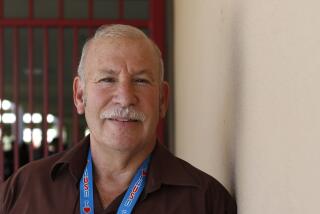Pasadenans Debate Plan to End Busing
A plan by the Pasadena school district’s new superintendent to end busing and emphasize neighborhood schools has been praised by some in the community, but has angered others. More of that debate is expected today during public hearings.
Supt. Percy Clark Jr.’s busing proposal is part of a larger improvement plan that he hopes will attract back to public schools some of the 8,000 Pasadena youngsters who now attend the more than 30 private schools in the area.
But that’s what worries some opponents. Fearing a return to segregation, they say the district should concentrate on helping the students who have remained in public schools. Supporters of the plan say that busing no longer makes sense since 85% of Pasadena’s public school students are black, Latino or Asian and re-segregation is improbable because so many of Pasadena’s neighborhoods have become residentially integrated.
One fault line appears to be a generational one, even within minority communities.
Maurice Morse, a black educator with the district for 39 years, remembers when she and others fought to get busing to desegregate schools in the ‘60s and ‘70s. If others fail to understand her passion on the issue, perhaps it is because “they just haven’t lived long enough.”
“They” are a younger generation of Pasadena residents. People like City Councilman Chris Holden, who was a middle school student in 1970, the year that the district began busing students under a court order. Holden, who is black, says the time for busing has passed.
Morse, although otherwise supportive of Clark, has a measured skepticism about what the end of busing will mean for the 23,500-student district, which includes Altadena and Sierra Madre.
“I can’t tell you how we’ll achieve integration without busing,” Morse said.
Morse and the other desegregation “warriors,” as Clark calls them, acknowledge that busing has not created the integrated Pasadena Unified School District they envisioned. After busing began in 1970, school attendance plummeted as many white families either left the district or enrolled their children in private schools.
About 2,300 students ride bus routes designed to create racial parity. But in many instances, minority students now are bused to schools where the student bodies are overwhelmingly black and Latino.
The ‘70s was a far different time, when Morse taught one of Pasadena’s first integrated classes--15 white and 11 black first-graders. One of the first black teachers to work in the district, Morse grew up in south Georgia and was educated in segregated schools until graduate school.
“Before busing, it was like we had two separate school districts,” she said of Pasadena. “We don’t want to go back to the way it was.”
Joe Hopkins, a Pasadena attorney and publisher of the black newspaper the Pasadena Journal, says he does not want to see the district spend money to woo white students back to the public schools rather than concentrating on the students who already are in the ailing district.
“They need to take that $8 million they’ll save from busing and hire tutors and mentors and home workers to teach them and read to them on a one-on-one basis,” he said. “Don’t take that money away from busing and improve the plight of the white kids.”
School board member Peter Soelter said the tension is this: “Who do we want to serve, students who are currently in the schools, or do we make schools more attractive to bring students back who are not in the district?”
Clark, who is black, insists that his plan will not resegregate the district and has many aspects geared to academic improvement. It calls for redrawing school attendance zones to create neighborhood schools, reopening closed campuses, changing grade configurations at some schools and creating more magnet programs.
Busing for purely transportation purposes and to relieve overcrowding will remain, even if the superintendent’s plan is adopted.
Holden has firsthand knowledge of busing’s pluses and minuses. He was a child of busing, and his four children ride buses for almost 40 minutes each way to and from school.
Although busing introduced him to a wider world, it “was disheartening, at the end of the day, getting on the bus with your black friends, leaving all your white friends, and passing all these other schools on the way to our homes,” Holden said.
“Neighborhoods [in Pasadena] are very much ethnically mixed,” he said. “Neighborhoods are diverse enough that neighborhood schools would be diverse. If kids can walk to school, they should be able to.”
Today, the community will have the opportunity to review the plan at Eliot Middle School, 2184 N. Lake Ave., Altadena, at 10:30 a.m.
More to Read
Sign up for Essential California
The most important California stories and recommendations in your inbox every morning.
You may occasionally receive promotional content from the Los Angeles Times.










